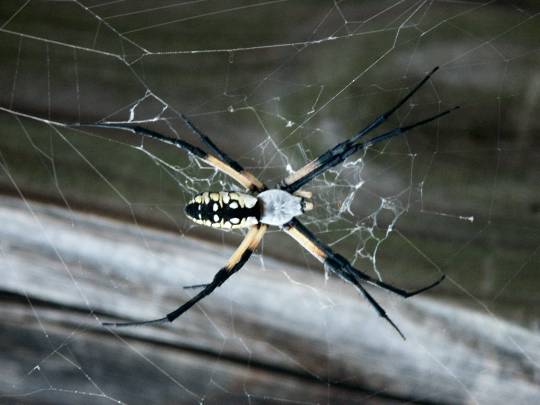
Gardening Snippet #2002-006
Yard & Garden Spiders
(friend or foe)
|
argiope, patiently awaiting her next meal... |
| |
 |
 |
| notes: |
1. Clicking on either image (above) displays larger photos within a new browser window. To continue browsing, close that window. |
2.
Photos are courtesy of a cooperative mother nature, my Minolta DiMage 5
(digital camera), yours truly, and the Aantares family of online
Communities. |
The yellow garden spider ("argiope" pictured above) is commonly found throughout much of the United States.
Should you happen to see argiope hanging around your garden or yard, I suggest that you leave her be...
but not because she poses any threat to you; quite to the contrary, because she is your ally! This spider makes a feast of
pests; such as flies, grasshoppers, moths, wasps, or any other insect which has the misfortune of becoming
entangled within its web. The argiope species of spiders is essentially harmless to humans and pets.
There are many thousands of spider species which may be found in and around the home and garden. All of them help us to naturally
control pests (without the use of chemical pesticides), and thus we should look upon them as our friends. Only a very few
species are dangerously poisonous to humans and pets. Within the United States, perhaps the most recognized (or maybe not so
recognized?) are these poisonous species: the southern black widow,
the northern black widow,
the western black widow,
the red widow,
the brown widow,
the (lesser known?) hobo,
and the brown recluse.
But on the whole, I think that we should:
- better understand the role which spiders play in nature
- consider all spiders as our allies in controlling insect pests
- leave them alone, and allow them to serve their natural purpose
- learn to recognize and avoid (and perhaps relocate) those which are poisonous
Listed below are some resources which might aide us in this quest:
unl.edu
... Department of Entomology, University of Nebraska-Lincoln: Spiders 1
unl.edu
... Department of Entomology, University of Nebraska-Lincoln: Spiders 2
unl.edu
... Department of Entomology, University of Nebraska-Lincoln: Spiders 3
floridanature.org
... be sure to scroll-down and see: "species listed on this site"
xs4all.nl
... there are 1960 primitive and 40000 modern species of spiders, yikes!
ufsia.ac.be
... a site dedicated to the study of arachnids
microscopy-uk.org.uk
... why spiders do not get stuck in their own webs
contact
... your state cooperative extension service for info about spiders in your locale
-- Karl
More Gardening Snippets
top of page
(NOTE: This "Gardening Snippet #2002-001" article and its associated images
are the copyrighted intellectual property of the author, and are being used here with the express
permission thereof. All rights are reserved by the author, who can be contacted at
.
|
|
|
|